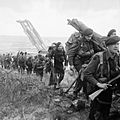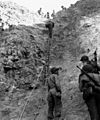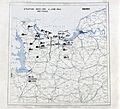D-Day facts for kids
Quick facts for kids D-Day |
|||||||||
|---|---|---|---|---|---|---|---|---|---|
| Part of Operation Overlord, the invasion of Normandy and the Western Front of World War II | |||||||||
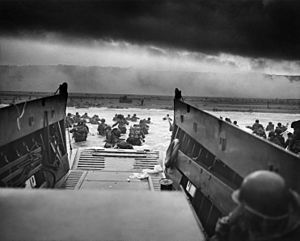 Men of the 16th Infantry Regiment, US 1st Infantry Division wading ashore on Omaha Beach on the morning of 6 June 1944 |
|||||||||
|
|||||||||
| Belligerents | |||||||||
Allies
|
|||||||||
| Commanders and leaders | |||||||||
|
|||||||||
| Units involved | |||||||||
|
Omaha Beach:
Utah Beach:
Gold Beach
Juno Beach
Sword Beach
|
South of Caen
Omaha
Utah Beach
Gold, Juno, and Sword
|
||||||||
| Strength | |||||||||
| 156,000 soldiers 195,700 naval personnel |
50,350+ 170 coastal artillery guns. Includes guns from 100mm to 210mm, as well as 320mm rocket launchers. |
||||||||
| Casualties and losses | |||||||||
| 10,000+ casualties; 4,414 confirmed dead 185 M4 Sherman tanks |
1,000 casualties | ||||||||
D-Day, also known as the Normandy landings, was a huge military operation during World War II. It happened on Tuesday, June 6, 1944. This day marked the start of the Allied invasion of Normandy, France.
The operation was codenamed Operation Neptune. It was the largest invasion by sea in all of history. Nearly 160,000 soldiers crossed the English Channel that day.
This massive landing began the process of freeing German-controlled France. It also set the stage for the Allies to win the war on the Western Front.
Contents
Planning the D-Day Invasion
Planning for this huge operation started in 1943. Before the invasion, the Allies used a clever trick. It was called Operation Bodyguard. They wanted to make the Germans think the invasion would happen somewhere else.
Adolf Hitler put Field Marshal Erwin Rommel in charge of German forces. Rommel worked on building strong defenses along the Atlantic Wall. This was a line of fortifications along the coast.
Weather Challenges for D-Day
The weather on D-Day was not perfect. The operation had to be delayed by 24 hours. If they waited longer, it would mean a two-week delay. This was because the invasion needed specific moon phases and tides.
Who Participated in D-Day?
The main ground forces came from American, British, and Canadian armies. Nine divisions landed on D-Day. More troops arrived in the weeks that followed.
The invasion fleet was enormous. It included 6,939 vessels from eight different navies. These included warships, transport ships, and support vessels.
Bombardment Before Landing
Before the troops landed, there was a huge attack from the air and sea. Also, 24,000 American, British, and Canadian paratroopers landed by air. This happened shortly after midnight.
General Dwight D. Eisenhower sent a famous message to all Allied soldiers. He told them they were starting a "great crusade." He also had a secret message ready if the invasion failed.
The Beach Landings
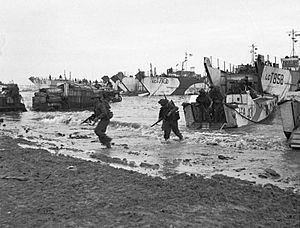
Allied soldiers and tanks started landing on the French coast at 6:30 AM. The target area was about 50 miles (80 km) of the Normandy coast.
This coast was split into five sections: Utah, Omaha, Gold, Juno, and Sword. Strong winds pushed some landing craft off course. This was especially true at Utah and Omaha.
The soldiers faced heavy fire from German guns. The beaches were also full of mines and obstacles. These included wooden stakes and barbed wire. This made it very dangerous for teams clearing the beaches.
The most casualties happened at Omaha Beach. This was because of its high cliffs. At Gold, Juno, and Sword, soldiers had to fight house-to-house in towns. Special tanks helped disable two big gun positions at Gold.
The Allies did not achieve all their goals on the first day. Towns like Carentan and Bayeux were still held by Germans. Caen, a major target, was not captured until July 21. Only two beaches (Juno and Gold) were connected on the first day. All five beachheads were not linked until June 12. However, the operation did create a strong starting point for the Allies.
Weapons Used on D-Day
The Allied forces used many different weapons and tanks. Here are some of the main ones:
Infantry Weapons
- M1 Garand semi-automatic rifle
- Thompson submachine gun
- Lee-Enfield No. 4 Mk I bolt-action rifle (British)
- Sten submachine gun (British)
Artillery and Anti-Tank Weapons
- 57mm anti-tank gun
- PIAT (Projector, Infantry, Anti-Tank) anti-tank weapon (British)
- M9 Bazooka rocket launcher
Machine Guns
- M1919 Browning machine gun
- Bren light machine gun (British)
Tanks and Vehicles
- M4 Sherman medium tank
- Churchill infantry tank (British)
- M10 Tank Destroyer
Special tanks were also used. These included amphibious (water-crossing) Shermans and tanks that cleared mines. Other armored vehicles transported troops and supplies.
Casualties of D-Day
German casualties on D-Day are estimated to be between 4,000 and 9,000 soldiers. Allied casualties were at least 10,000. Of these, 4,414 were confirmed dead. Today, museums and cemeteries in the area welcome many visitors each year.
War Memorials and Tourism
The beaches in Normandy are still known by their invasion codenames. There are several large cemeteries in the area.
The American cemetery is in Colleville-sur-Mer. It has rows of white crosses and Stars of David. These honor the American soldiers who died.
Commonwealth graves use white headstones. They are engraved with religious symbols and unit badges. The largest cemetery is the La Cambe German war cemetery. It has granite stones close to the ground. There is also a Polish cemetery.
Streets near the beaches are named after the military units that fought there. Markers also remember important events. Every year on June 6, Charles M. Schulz, the creator of Peanuts, honored his comrades who died at Normandy in his comic strip.
Interesting Facts About D-Day

- The 'D' in D-Day simply stands for 'Day'. It was a term used for the day of any important military operation.
- D-Day was just the start of a campaign that lasted about 12 weeks.
- The Normandy landings were the largest invasion by sea in history.
- Thousands of paratroopers landed first, but only 15% landed in the right place.
- Adolf Hitler was asleep when the Allied forces landed.
- There were five beaches where the landings happened: Sword, Juno, Gold, Omaha, and Utah.
- Before D-Day, the BBC ran a fake competition. People were asked to send in French beach holiday photos. These were secretly sent to the War Office to help plan the landings.
D-Day in Popular Culture
Books About D-Day
- The Longest Day by Cornelius Ryan (1959)
- D-Day: The Battle for Normandy by Antony Beevor (2009)
Films and TV Shows About D-Day
- The Longest Day (1962 film)
- Saving Private Ryan (1998 film)
- Band of Brothers (2001 miniseries)
Related pages
Images for kids
-
Meeting of the Supreme Headquarters Allied Expeditionary Force (SHAEF), 1 February 1944. Front row: Air Chief Marshal Arthur Tedder; General Dwight D. Eisenhower; General Bernard Montgomery. Back row: Lieutenant General Omar Bradley; Admiral Bertram Ramsay; Air Chief Marshal Trafford Leigh-Mallory; Lieutenant General Walter Bedell Smith.
-
Surface weather analysis map showing weather fronts on 5 June
-
Map of the Atlantic Wall, shown in yellow Axis and occupied countries Allies and occupied countries Neutral countries
-
Czech hedgehogs deployed on the Atlantic Wall near Calais
-
Royal Marine Commandos attached to 3rd Infantry Division move inland from Sword Beach, 6 June 1944
-
Members of the French Resistance and the US 82nd Airborne division discuss the situation during the Battle of Normandy in 1944.
-
D-Day planning map, used at Southwick House near Portsmouth
-
Large landing craft convoy crosses the English Channel on 6 June 1944
-
Gliders are delivered to the Cotentin Peninsula by Douglas C-47 Skytrains. 6 June 1944
-
U.S. assault troops in an LCVP landing craft approach Omaha Beach, 6 June 1944.
-
British troops take cover after landing on Sword Beach.









